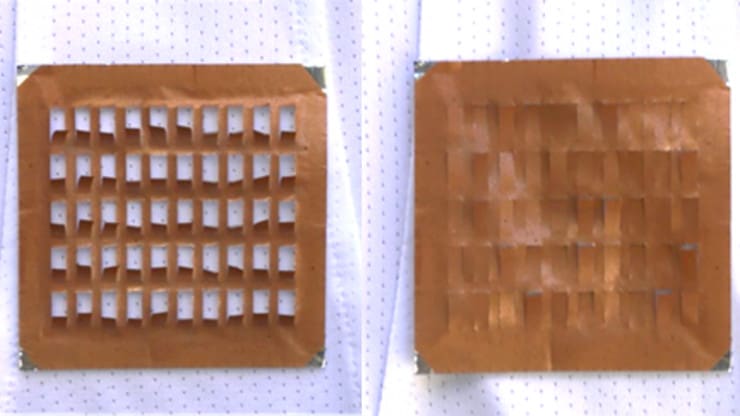Materials Scientists at Duke University have developed a lightweight material that traps thermal energy when dry, but opens a series of tiny vents to let heat escape when a person starts sweating. The vents close again to retain heat once they are dry.
Using physics rather than electronics to open the vents, the material has potential as a patch on various types of clothing to help keep the wearer comfortable in a wide range of situations.
The approach is described online on December 15 in the journal Science Advances.
“People who are skiing or hiking in colder weather usually wear layers so they can adjust how much heat their clothing is trapping as their body heats up,” said Po-Chun Hsu, assistant professor of mechanical engineering and materials science at Duke. “But by strategically placing patches of a material that can let out heat when a person is sweating, one could imagine making a one-piece-fits-all textile.”
When first attempting to make such a dual-purpose material, Hsu turned to nylon. It’s inexpensive, lightweight and soft, and Hsu knew that if cut into flaps, nylon curls in on itself a little bit when one side is exposed to moisture.
Nylon is not, however, known for making particularly warm clothing, so Hsu added a layer of heat-trapping silver on top. Expecting the weight of the silver to bog down the nylon flaps, he tried to make the layer as thin as possible. But to his surprise, the silver addition actually made the flaps curl back even more.
After experimenting with various thicknesses of silver, Hsu discovered a Goldilocks spot around 50 nanometers—2,000 times thinner than a sheet of paper. Any thinner and the phenomena wouldn’t be as strong. Any thicker and the weight of the silver started interfering with the vents opening.
Puzzled as to what exactly was happening on his lab bench, Hsu turned to Cate Brinson, the Sharon C. and Harold L. Yoh, III Distinguished Professor and Donald M. Altstadt Chair of Mechanical Engineering and Materials Science at Duke. Working with a postdoctoral researcher in her laboratory, Boran Ma, Brinson was able to provide an explanation.

A single strip of nylon/silver material curls back in response to moisture. If miniaturized and placed over a large area, researchers hope to make a patch that keeps people warm when the vents are closed, but vents heat in response to sweat.
“It’s surprising and counterintuitive, but adding something heavy on top of a polymer can actually make it bend and open more,” Brinson said. “What it comes down to is that the silver is shrinking and the nylon is expanding.”
Brinson and Ma explained that when the bottom layer of nylon gets wet, it wants to expand like a sheet being pulled from its sides. But because it’s attached to the silver on top, it can’t stretch in those directions. The easiest option remaining is for the two-layer material to curl up, allowing the nylon to expand while forcing the silver to shrink.
In the experiments, the researchers created a patch about the size of a human hand with flaps a few millimeters long—about the size of a fingernail. Compared with an average traditional textile represented by a blend of polyester and spandex, the material is about 16% warmer when dry with the flaps closed and 14% cooler when humid with the flaps open. Put together, the nylon-silver hybrid can expand the thermal comfort zone by 30%. According to Hsu, this approach has advantages to existing methods of venting heat through warm clothing, such as placing zippers beneath the armpits.
“We want the sweating parts of the body to be vented, which is not necessarily the underarms,” Hsu said. “Our chest and back need more venting, but the effort to unzip these areas, if zippers are even available, is almost the same as simply taking off the clothing.”
Moving forward, Hsu is working on making the vents as small as possible while retaining their effectiveness. He’s also exploring using a top nanocomposite layer that could make the material any color without changing its thermal attributes.
“I expect that if we can find the right laser cutting method to create very small flaps and attach the patch to clothing, we can create this effect without looking like we’re wearing a costume,” said Hsu. “With enough work, this kind of material could look very similar to what we’re wearing today.”
This work was supported by the National Science Foundation DMREF program (CMMI-1818574) and CSSI program (CSSI-1835677).
CITATION: “Metalized Polyamide Heterostructure as a Moisture-Responsive Actuator for Multimodal Adaptive Personal Heat Management,” Xiuqiang Li, Boran Ma, Jingyuan Dai, Chenxi Sui, Divya Pande, David R Smith, L. Catherine Brinson, Po-Chun Hsu. Science Advances, Dec. 16, 2021. DOI: 10.1126/sciadv.abj7906


